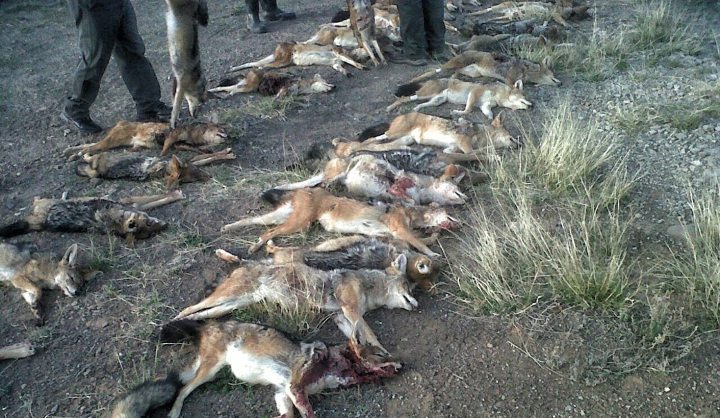South Africa
Letter to the Editor: No jackals killed by scientists, research is novel, worthy and sound

A Daily Maverick Op-Ed by Don Pinnock on jackals in national parks has drawn a response from Nelson Mandela Metropolitan University whose Prof BLANCHE PRETORIUS writes to “set the record straight”.
No jackals whatsoever were killed or culled by or at the request of the scientists from Nelson Mandela Metropolitan University (NMMU) who authored an article on jackals published in the Journal of Applied Ecology, Volume 53, Issue 2, as was alleged in the regrettable and baseless Op-Ed by Don Pinnock in the Daily Maverick (18 January, 2017), 573 dead jackals in search of a reason.
The lead author of the NMMU article, Compensatory life-history responses of a mesopredator may undermine carnivore management efforts, is Dr Liaan Minnie whose PhD was supervised by co-author, Distinguished Professor Graham Kerley, both of the Centre for African Conservation Ecology, Department of Zoology, NMMU.
The article undermined lead author Dr Minnie’s integrity and research ethics as well as those of NMMU by strongly suggesting that this paper, which was part of Dr Minnie’s PhD submission, is based on fraudulent and unethical research. This is potentially libellous.
In response, NMMU is taking this opportunity to set the record straight.
Pinnock e-mailed NMMU’s Deputy Vice-Chancellor of Research and Engagement, Professor Andrew Leitch, for comment at the end of last year. He explained to Pinnock he was personally not able to give it attention at the time as he was focusing on the university’s academic completion programme following the FeesMustFall protest shutdown.
“What concerns me is that the journalist did not at any time see fit to contact either Dr Minnie or myself to get our direct input when he knows exactly where to find us,” says Prof Kerley. “We are happy to discuss our research, which was already written about in the South African media last year, and we would have gone through each and every aspect of our process with him.”
Prof Kerley is a renowned zoologist and conservation ecologist. Such is his reputation that in 2015 he was awarded the Gold Medal of the Zoological Society of Southern Africa (ZSSA) for outstanding achievements in Zoology and Conservation Ecology in southern Africa and internationally.
“The DM article calls into question journalistic ethics and responsible journalism. The piece is extremely unbalanced, unfounded and damaging to the reputation and future of Dr Minnie, an excellent young scientist. The allegations made in the article against our research processes are untruthful, flawed and unfounded,” says Prof Kerley.
“The author of the DM article is surely also well aware of the stringent ethics approval process required by all universities for any animal research. Yet he failed to contact the chair of the Research Ethics Committee: Animals at NMMU, Professor Gill Dealtry, to ascertain whether Dr Minnie had received ethics approval for this research in 2011 before he started his research, which he most certainly did. All documentation is available and on record.”
Prof Dealtry says: “From the Research Ethics Committee: Animals (REC-A) side, at all times ethical permission was sought by Dr Liaan Minnie who first contacted me in May 2011 and the REC-A committee gave permission for him to use the samples. We also established at the time of the SANParks jackal cull that Dr Minnie, Professor Kerley and NMMU had no involvement in SANParks’ decision to cull or in the planning of the cull.”
The research from the published article is based on a sample size of 573 jackals. Not one of these jackals was killed at the request, bequest or encouragement of Dr Minnie and Prof Kerley.
A decision was taken by the SANParks board to cull a certain number of black-backed jackals on certain national reserves in the Western and Eastern Cape, including parts of Addo Elephant National Park, the Karoo National Park and subsequently the Mountain Zebra National Park, as they felt this would reduce the pressure on their diminishing smaller antelope populations, including springbuck. This decision had nothing whatsoever to do with Dr Minnie’s research. Neither did the on-farm hunts have anything to do with his research.
Anyone who is acquainted with livestock farming in the Karoo knows that many farmers routinely hunt black-backed jackals and caracal, which prey on livestock.
Predators like the black-backed jackal are costing South Africa more than R1.3-billion per year in livestock losses of sheep and goats. The annual loss of cattle to jackal predation is more than R380-million and a similar situation of huge losses applies to antelope on wildlife ranches. This equates to losses of over R2-billion per year.
The issue of the killing, culling, cost or management of the jackal is a separate debate. The point is that the 573 jackals were categorically not killed or culled for the academic study, as the article alludes.
“I received full permission to measure and sample the carcasses of the nature reserve and on-farm jackals in order to advance a better understanding of jackal biology towards the promotion of sound conservation and management of these mesopredators,” says Dr Minnie.
“I was informed when the jackals were to be culled or killed, and I then went to the sites straight afterwards and collected an extensive set of samples from these dead jackals. These samples represented critical research and included information on the genetics, diet, reproduction and population structure of these jackal populations.”
From this research, the team was able to determine that on the farms where jackals are hunted about 68% of one to two-year-old females that have only just left their parents at 11 months, are already breeding. The average age of the jackal population on farms where they are hunted is two to three years.
On the reserves, by comparison, only 20% of this age group is breeding. On average, it may take jackal populations on reserves three years longer to achieve the same level of reproduction than jackals on farms are showing.
Jackal females can live to seven years+, producing an average of three to 3.5 pups per year. Research suggests that young female jackals on reserves are socially constrained from breeding in the natural territorially-maintained hierarchy, and may only breed when they attain a territory or acquire enough food resources to get their body condition up to reproductive form.
This research is the first time that the response of jackal to lethal management has been rigorously quantified in South Africa, and it strongly indicates that killing jackal may not be an effective long-term strategy. These are novel findings, and will be of value to the livestock producers, conservation managers and policy developers. Until these findings were made available, these issues were a matter of conjecture and opinion.
The article calls this “old information” and bases the attack on the opinions of independent predator researcher, Rob Harrison-White, and Dr Bool Smuts of the Landmark Foundation who has regrettably chosen to widely publish the DM article on social media.
During 2016 Harrison-White and Smuts complained to NMMU about the killings and that the findings were fraudulent since Minnie had referred to the group of 246 culled jackals he had sampled from the Karoo National Park, the Mountain Zebra National Park and the Addo Elephant National Park, as the “unhunted” group and the on-farm group as the “hunted” group.
Harrison-White and Smuts contacted the Vice-Chancellor and Deputy Vice-Chancellor of Research & Engagement at NMMU, and the editor of the Journal of Applied Ecology and said it was fraudulent to cite data from a nature reserve defined as “unhunted” prior to 2013 as a cull had taken place in 2010 in certain parts of the Addo Elephant Park and the Karoo National Park. The Mountain Zebra National Park’s first cull was in 2013, and could therefore be termed unhunted.
Harrison-White well knows about the 2010 cull as he himself reported to NMMU that he had taken measurements and samples from this cull, presumably with an ethics permit and a research permit, and presumably without encouraging the cull for his research.
Dr Minnie is completely open about the fact that some of the reserves were hunted in 2010, and explains that he used the phrase “unhunted” not to be misleading but because the population age structure from those hunted in 2010 and the unhunted reserves were the same.
“Prior to the submission of our paper, we compared the jackal population age structure of all the reserves in question, and found that there was no statistical difference between reserves that were previously hunted in 2010 and unhunted reserves. Therefore, these reserves were grouped into a single unhunted category. The terms ‘unhunted’ and ‘hunted’ were simply used to describe two very different population response outcomes – on the reserves and on the farms,” Dr Minnie explains.
He is also completely open about the fact that Harrison-White had provided them with his data from the 2010 cull after the publication of their article in 2016. Subsequently, he compared this data and found that Harrison-White’s 2010 data and their 2013 data was the same statistically.
During the course of 2016 NMMU repeatedly went out of its way to investigate all the questions and issues raised by Harrison-White and Smuts, as the Deputy Vice-Chancellor of Research and Engagement, Professor Andrew Leitch, explains: “A comprehensive investigation was conducted by an ad-hoc committee comprising members of our NMMU’s Ethics Committee. I then e-mailed the document of these findings to Harrison-White and to the editor of the Journal of Applied Ecology, Erika Newton and all those concerned.
“I thanked Harrison-White for his interest in Nelson Mandela Metropolitan University, and ‘for bringing this matter to our attention. As a public institution named after our President Nelson Mandela, we pride ourselves in ethical conduct in accordance with accepted international norms’.”
“When this response was not accepted by Harrison-White and Smuts, in consultation with the Editor of the Journal of Applied Ecology, in 2016 we engaged an independent reviewer to provide both a scientific and an ethics opinion on the matters raised,” Prof Leitch continues.
The independent review, conducted by respected mammal scientist, Professor Dan Parker, was once again circulated to all. He pointed out in his report that the authors were remiss in not disclosing the information about the 2010 cull in their paper and recommended that the authors submit an explanation as to why they did not disclose the information about the 2010 cull in their submission, and left it up to the Journal of Applied Ecology’s editorial board to decide on the course of action.
The editor requested the authors to provide a detailed response, which they did. The outcome was that the board decided to retain the paper in the Journal of Applied Ecology as the science remains sound, and to publish a corrigendum or clarification in a subsequent issue where the use of the terms “unhunted” and “hunted” in the context of the article would be explained and revised to “lightly hunted” and “heavily hunted”.
Prof Kerley concludes that what is important to achieve from this kind of research is to bring all participants together to understand what is happening with the jackal and other predator populations, such as caracal and leopard, on both conservation areas and on farms, and to work together towards more effective, collective conservation and management approaches. DM
Prof Blanche Pretorius is Director: Research Capacity Development at Nelson Mandela Metropolitan University.
Photo: Jackal cull in Karoo NP 2012.

















